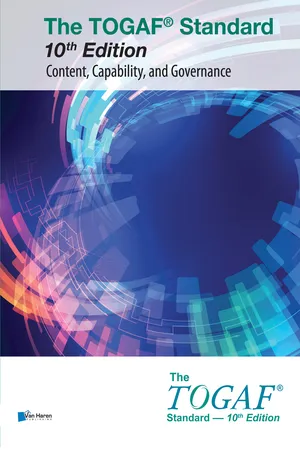![]()
The TOGAF Standard
The TOGAF® Standard, 10th Edition — Architecture Content
The Open Group
![]()
Chapter 1: Introduction
This chapter provides an introduction to the guidance provided in the TOGAF Standard — Architecture Content (this document).
1.1 Overview
Architects executing the Architecture Development Method (ADM) will produce a number of outputs as a result of their efforts, such as process flows, architectural requirements, project plans, or project compliance assessments. The Content Framework provides a structural model for architectural content that allows the major work products that an architect creates to be consistently defined, structured, and presented.
The Content Framework provided here is intended to allow the TOGAF framework to be used as a stand-alone framework for architecture within an enterprise. However, other Content Frameworks exist (such as the Zachman® Framework) and it is anticipated that some enterprises may opt to use an external framework in conjunction with the TOGAF framework. In these cases, the TOGAF Content Framework provides a useful reference and starting point for TOGAF content to be mapped to other Content Frameworks.
The Architecture Content Framework uses the following three categories to describe the type of architectural work product within the context of use:
■ A deliverable is a work product that is contractually specified and in turn formally reviewed, approved, and signed off by the stakeholders
Deliverables represent the output of projects and those deliverables that are in documentation form will typically be archived at completion of a project, or transitioned into an Architecture Repository as a reference model, standard, or snapshot of the Architecture Landscape at a point in time.
■ An artifact is an architectural work product that describes an aspect of the architecture
Artifacts are generally classified as catalogs (lists of things), matrices (showing relationships between things), and diagrams (pictures of things). Examples include a requirements catalog, application interaction matrix, and a value chain diagram. An architectural deliverable may contain many artifacts and artifacts will form the content of the Architecture Repository.
■ A building block represents a potentially re-usable component of enterprise capability that can be combined with other building blocks to deliver architectures and solutions
Building blocks can be defined at various levels of detail, depending on what stage of architecture development has been reached. For instance, at an early stage, a building block can simply consist of a name or an outline description. Later on, a building block may be decomposed into multiple supporting building blocks and may be accompanied by a full specification. Building blocks can relate to "architectures" or "solutions".
— Architecture Building Blocks (ABBs) typically describe what is required of SBBs at a more logical or supplier-independent level; those requirements may include services to be performed, data resources, and capabilities needed. ABBs include logical business, application, and technology components
— Solution Building Blocks (SBBs) represent physical or supplier-specific components that have the capability to realize part or all of a more logical ABB. There are business, application, and technology SBBs.
The relationships between deliverables, artifacts, and building blocks are shown in Figure 1-1.
Figure 1-1 Relationships between Deliverables, Artifacts, and Building Blocks
For example, an Architecture Definition Document is a deliverable that documents an Architecture Description. This document will contain a number of complemen...

